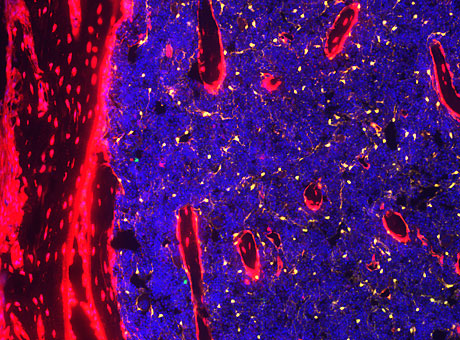
Distinct niches exist in bone marrow to nurture different types of blood stem cells. In mice bone marrow, blood stem cells, highlighted in blue, are nurtured by support cells shown in red and yellow.

Distinct niches exist in bone marrow to nurture different types of blood stem cells. In mice bone marrow, blood stem cells, highlighted in blue, are nurtured by support cells shown in red and yellow.
In research that could one day improve the success of stem cell transplants and chemotherapy, scientists have found that distinct niches exist in bone marrow to nurture different types of blood stem cells.
Stem cells in the blood are the precursors to infection-fighting white blood cells and oxygen-carrying red blood cells.
The research, by a team at the School of Medicine, was reported Feb. 24 in the advance online edition of Nature.
The new findings, in mice, suggest that it may be possible to therapeutically target support cells in a particular niche.
On the one hand, a drug that nourishes support cells could encourage blood stem cells to establish themselves in the bone marrow, enabling patients who have had stem cell transplants to more quickly rebuild their immune systems.
On the other, tumor cells are known to hide in the bone marrow, and a drug that disrupts the niche environment may drive cancer cells into the bloodstream, where they are more vulnerable to the damaging effects of chemotherapy.
“Our results offer hope for targeting these niches to treat specific cancers or to improve the success of stem cell transplants,” says senior author Daniel C. Link, MD, the Alan A. and Edith L. Wolff Professor of Medicine. “Already, we and others are leading clinical trials to evaluate whether it is possible to disrupt these niches in patients with leukemia or multiple myeloma.”
In a phase II pilot study led by medical oncologist Geoffrey L. Uy, MD, assistant professor of medicine, Link is evaluating whether the drug G-CSF can alter the stem cell niche in patients with acute lymphoblastic leukemia whose cancer has recurred or is resistant to treatment.
While it’s too early to know whether the treatment approach will be successful, Link’s new research in mice is bolstered by a companion paper in the same issue of Nature. In that research, Sean J. Morrison, PhD, director of the Children’s Medical Center Research Institute at the University of Texas Southwestern Medical Center in Dallas, used similar molecular methods to also discover distinct niches in the bone marrow for blood stem cells.
“There’s a lot of interest right now in trying to understand these niches,” Link adds. “Both of these studies add new information that will be important as we move forward.”